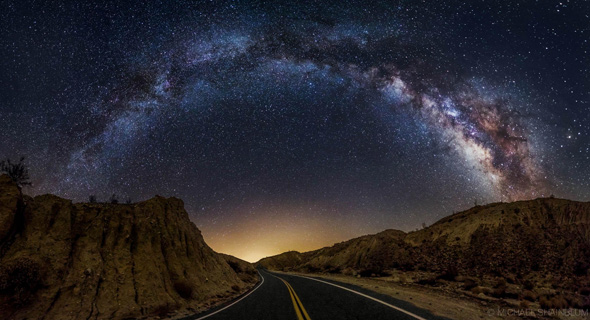Astrophoto: The Arch of the Galaxy
Just the other day, scifi author (and devoted churro fanatic) John Scalzi tweeted, “I've said it before but it's worth repeating: I love living somewhere I can see the Milky Way.”
I agree (and told him so).
Living in an area with only mild light pollution—light from buildings,
cars, street lights, and so on, leaking upward into the air and
illuminating it—means when I walk outside into my back yard, I can
immediately see lots of stars. Give me 15 minutes to let my eyes adapt
to the darkness and it’s quite lovely here in Boulder. I can see the
Milky Way as a faint, fuzzy stream across the sky.
But I’ve been to darker sites, places much farther from the lights of
civilization, where the Milky Way is even more stunning. Still, the
combined might of a hundred billion stars is reduced to a faint glow
here on Earth, so the darker the sky, the higher the contrast, and the
easier to see our galaxy’s wonder.
This is why I’m a tad jealous of photographer Mike Shainblum,
who traveled into the Anza Borrego desert in southern California, a
couple of hundred kilometers east of San Diego. The skies there get
pretty dark, and the dry air cuts back on the scattered light from
cities. Searching for the perfect road to make his foreground, he took this amazing picture of the galaxy in which we live:

Photo by Michael Shainblum, used by permission
This shot is actually a mosaic of 14 separate pictures, carefully
merged into one big image. It’s a bit distorted; that’s a consequence of
using a wide-angle lens and putting together so many separate shots.
But still, it’s gorgeous. The central hub
of the galaxy is obvious on the right, splashed with dark dust lanes
that absorb the starlight from behind them, reddening it as well in much
the same way dust in the air makes a sunset look aflame.
You can trace the dust to the left, following the plane of the Milky Way.
Our galaxy is actually shaped like a huge disk, 100,000 light years
across and about 1000 light years thick. In proportion, it’s about the
same as three DVDs stacked together. We live inside the disk, so we see
it edge-on, a thick stream of stars, gas, and dust strewn across the
sky.
Light pollution dims this magnificence easily, but can also add some
art to the picture; distant cities in Mexico punctuate the horizon in
Shainblum’s picture, adding a splash of yellow for contrast.
Shainbloom is a gifted photographer; I featured his time-lapse video “Existence” on the blog a few months ago, and his astrophotos are simply spectacular. It’s well worth your time to peruse them.
Tip o’ the lens cap to Raphael Fraser on Twitter.
Labels: Astronomy, Photography, Science, Space


0 Comments:
Post a Comment
<< Home